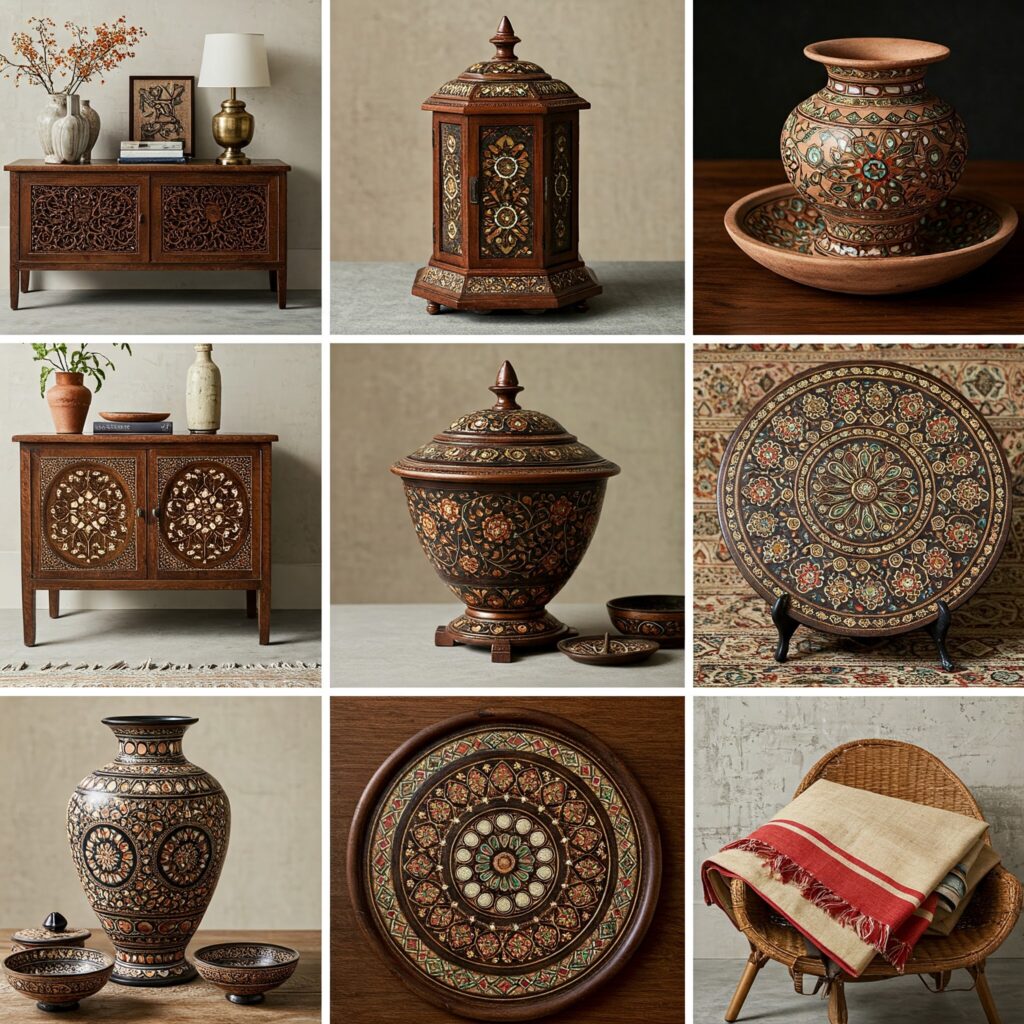
HandiCrafte of India : India is a land rich in history, culture, and craftsmanship. The handicrafts of India are a reflection of the country’s diverse heritage, offering a glimpse into its traditions, regional diversity, and artistic excellence. For centuries, the artisans of India have crafted unique and intricate pieces using traditional methods passed down through generations. Whether it’s vibrant textiles, delicate pottery, or intricately carved woodwork, handicrafts of India are more than just decorative items—they are a testament to India’s culture and creativity.
In this blog, we will explore the rich variety of handicrafts of India, highlighting some of the most famous crafts from different regions. Additionally, we’ll guide you on how to buy authentic handmade crafts from trusted sources like Sigma Handicraft.
1. Handicrafts of India : The Rich Heritage of Handicrafts in India
India’s handicrafts represent the confluence of age-old traditions and the artistic genius of local artisans. These crafts date back thousands of years and are integral to India’s cultural identity. From the ornate designs of Rajasthan to the intricate patterns of Kashmir, the handicrafts of India are a perfect blend of artistry and skill.
India’s handicrafts not only play an important role in the country’s economy but also offer an avenue for preserving cultural traditions. The vastness and diversity of India ensure that each region produces its own distinct style of handicrafts, reflecting the local culture, materials, and history.
The Role of Handicrafts in Indian Culture:
- Cultural Expression: Each handicraft showcases the unique style and traditions of different regions and communities in India.
- Sustainability: Many of the crafts are made using natural and sustainable materials like wood, stone, clay, and textiles.
- Community Identity: Handicrafts provide a sense of identity for artisans, as they are often passed down through generations within families or communities.
2. Types of Handicrafts in India
India is home to a wide array of handicrafts that are famous for their beauty and intricacy. These include textiles, pottery, metalwork, woodwork, and jewelry, among others. Let’s take a closer look at some of the most popular handicrafts of India:
2.1. Textiles and Fabrics
Indian textiles are known for their vibrant colors, patterns, and intricate designs. From handwoven cotton to luxurious silk, Indian fabrics are used to create a wide range of products, including sarees, shawls, scarves, and home décor items.
Famous Indian Textile Crafts:
- Banarasi Saree (Uttar Pradesh): Known for its rich silk fabric and intricate gold or silver zari work.
- Kalamkari (Andhra Pradesh and Telangana): A form of hand-painted or block-printed textile using natural dyes.
- Khadi (Pan-India): A fabric made from handspun yarn, symbolizing India’s independence and promoting sustainable fashion.
- Pashmina Shawl (Kashmir): Luxurious wool known for its warmth and fine texture.
2.2. Pottery and Ceramics
Pottery is one of the oldest forms of handicrafts in India. The craft involves shaping clay into functional and decorative items, which are then fired to harden them. Indian pottery comes in various styles and forms, with some regions being more renowned for their distinct methods.
Famous Pottery Styles:
- Blue Pottery (Rajasthan): Known for its vibrant blue color and intricate designs.
- Terracotta (West Bengal and Tamil Nadu): Crafted using raw clay, these items are fired and often painted with bright colors.
- Khurja Pottery (Uttar Pradesh): Renowned for its floral designs and multicolored motifs.
2.3. Woodwork and Carving
Woodcraft is another traditional craft in India, especially prevalent in states like Rajasthan, Kerala, and Karnataka. The fine artistry of woodcarving involves intricate designs that reflect the cultural and religious diversity of the country.
Famous Wooden Handicrafts:
- Sandalwood Carving (Karnataka): Known for its smooth texture and aromatic scent, often used in creating small sculptures and decorative items.
- Madhubani Woodcraft (Bihar): Hand-carved wooden pieces often painted with vibrant Madhubani art.
- Rajasthani Woodwork: Known for intricate carvings on wooden furniture and doors.
2.4. Metalwork and Jewelry
Indian metalwork is one of the finest examples of craftsmanship. The intricate designs and the use of various metals, including gold, silver, brass, and copper, make Indian metal handicrafts highly sought after across the globe.
Famous Metal Crafts:
- Bidriware (Karnataka): A form of metal inlay work using a combination of silver and zinc.
- Brass and Copperware (Madhya Pradesh): Known for handcrafted kitchenware and decorative items.
- Kundan Jewelry (Rajasthan): A traditional form of jewelry where gemstones are set in gold foil.
3. How to Buy Authentic Handicrafts of India
When purchasing handicrafts of India, it’s important to ensure you are buying authentic items that reflect the quality and craftsmanship of the artisans. The rise of online platforms has made it easier for buyers to access handmade crafts from India, but it is essential to shop from trusted sources.
One such trusted platform is Sigma Handicraft, offering a curated collection of handcrafted products that bring the rich heritage of Indian craftsmanship directly to your home.
Tips for Buying Authentic Handicrafts:
- Research the Craft: Understand the history and techniques behind the craft before making a purchase.
- Check the Source: Ensure the seller is reputable and provides information about the artisans and their work.
- Support Fair Trade: Look for platforms that support fair wages for artisans and encourage ethical practices.
For authentic and ethically sourced handicrafts of India, visit Sigma Handicraft.
4. The Future of Handicrafts in India
With the rise of fast fashion and mass-produced goods, many traditional handicrafts in India face the challenge of remaining relevant in modern times. However, there is a growing movement toward preserving these crafts and ensuring that artisans continue to have a platform to showcase their work.
Key Trends in the Handicraft Industry:
- Sustainability: A growing demand for eco-friendly and sustainable products is benefitting traditional crafts that use natural materials.
- Global Reach: With the advent of e-commerce, Indian handicrafts are reaching a global audience, helping artisans access international markets.
- Integration with Modern Design: Many artisans are now blending traditional techniques with contemporary designs to create items that appeal to modern sensibilities.
Conclusion
The handicrafts of India are a true reflection of the country’s rich cultural history and artistic prowess. From textiles and pottery to metalwork and woodcarving, each craft showcases the talent and dedication of artisans who continue to uphold centuries-old traditions. By supporting these crafts, you not only bring beautiful and unique items into your home but also help sustain the livelihoods of artisans across the country.
For authentic handicrafts of India, whether it’s a handmade pottery piece, beautiful wooden sculpture, or intricately designed jewelry, make sure to visit trusted platforms like Sigma Handicraft.
Explore more about Indian craftsmanship and discover the best traditional crafts at National Handicrafts and Handlooms Museum.
handicrafts of India handicrafts of India handicrafts of India handicrafts of India handicrafts of India handicrafts of India handicrafts of India handicrafts of India handicrafts of India handicrafts of India handicrafts of India handicrafts of India handicrafts of India handicrafts of India handicrafts of India
